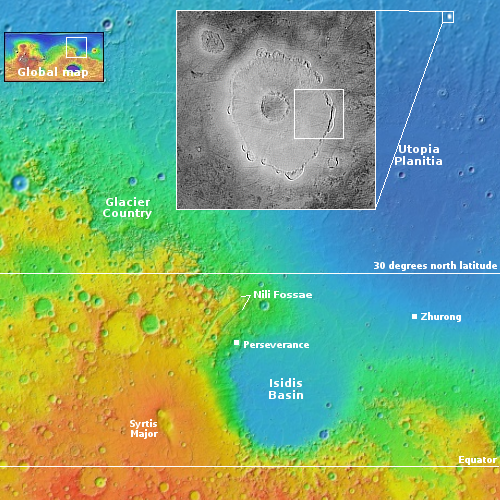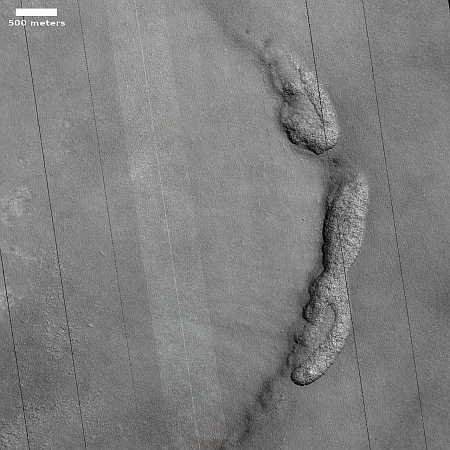Pits formed from sublimating underground ice on Mars?
Cool image time! The picture to the right, cropped, reduced, and sharpened to post here, was taken on October 31, 2024 by the high resolution camera on Mars Reconnaissance Orbiter (MRO).
The science team labels this “Impact Ejecta with Marginal Pits,” though even on the full image I am not sure what the impact ejecta is. The pits themselves appear to have formed when near-surface ice sublimated away during the summer months. The location is at 59 degrees north latitude, deep within the Martian northern lowland plains. Since orbital data suggests much of those plains at this latitude has an ice table of some thickness near the surface, it is very reasonable to assume these pits formed when summer sunlight heated that ice, turning it to gas which eventually pushed out to form the pits.
But what about the impact ejecta? Where is it? And where is the crater from that impact?

The white dot on the overview map to the right marks the location, just beyond the northern fringes of Utopia Basin, one of Mars’ handful of gigantic impact basins formed billions of years ago during the Late Heavy Bombardment when the planets were coalescing.
The inset explains all. These pits formed at the margin of the splash apron surrounding this unnamed two-mile-wide crater. That splash apron is the ejecta, and adds further evidence that there is a significant ice table here, very close to the surface. When the bolide hit the ground, the ice-impregnated ground acted more like a puddle of water, the ice quickly melting and splashing outward before quickly refreezing)
The pits likely formed along that margin because it was a weak point in the top surface, weak enough for the sublimated gas to break through.
On Christmas Eve 1968 three Americans became the first humans to visit another world. What they did to celebrate was unexpected and profound, and will be remembered throughout all human history. Genesis: the Story of Apollo 8, Robert Zimmerman's classic history of humanity's first journey to another world, tells that story, and it is now available as both an ebook and an audiobook, both with a foreword by Valerie Anders and a new introduction by Robert Zimmerman.
The print edition can be purchased at Amazon or from any other book seller. If you want an autographed copy the price is $60 for the hardback and $45 for the paperback, plus $8 shipping for each. Go here for purchasing details. The ebook is available everywhere for $5.99 (before discount) at amazon, or direct from my ebook publisher, ebookit. If you buy it from ebookit you don't support the big tech companies and the author gets a bigger cut much sooner.
The audiobook is also available at all these vendors, and is also free with a 30-day trial membership to Audible.
"Not simply about one mission, [Genesis] is also the history of America's quest for the moon... Zimmerman has done a masterful job of tying disparate events together into a solid account of one of America's greatest human triumphs."--San Antonio Express-News
Cool image time! The picture to the right, cropped, reduced, and sharpened to post here, was taken on October 31, 2024 by the high resolution camera on Mars Reconnaissance Orbiter (MRO).
The science team labels this “Impact Ejecta with Marginal Pits,” though even on the full image I am not sure what the impact ejecta is. The pits themselves appear to have formed when near-surface ice sublimated away during the summer months. The location is at 59 degrees north latitude, deep within the Martian northern lowland plains. Since orbital data suggests much of those plains at this latitude has an ice table of some thickness near the surface, it is very reasonable to assume these pits formed when summer sunlight heated that ice, turning it to gas which eventually pushed out to form the pits.
But what about the impact ejecta? Where is it? And where is the crater from that impact?

The white dot on the overview map to the right marks the location, just beyond the northern fringes of Utopia Basin, one of Mars’ handful of gigantic impact basins formed billions of years ago during the Late Heavy Bombardment when the planets were coalescing.
The inset explains all. These pits formed at the margin of the splash apron surrounding this unnamed two-mile-wide crater. That splash apron is the ejecta, and adds further evidence that there is a significant ice table here, very close to the surface. When the bolide hit the ground, the ice-impregnated ground acted more like a puddle of water, the ice quickly melting and splashing outward before quickly refreezing)
The pits likely formed along that margin because it was a weak point in the top surface, weak enough for the sublimated gas to break through.
On Christmas Eve 1968 three Americans became the first humans to visit another world. What they did to celebrate was unexpected and profound, and will be remembered throughout all human history. Genesis: the Story of Apollo 8, Robert Zimmerman's classic history of humanity's first journey to another world, tells that story, and it is now available as both an ebook and an audiobook, both with a foreword by Valerie Anders and a new introduction by Robert Zimmerman.
The print edition can be purchased at Amazon or from any other book seller. If you want an autographed copy the price is $60 for the hardback and $45 for the paperback, plus $8 shipping for each. Go here for purchasing details. The ebook is available everywhere for $5.99 (before discount) at amazon, or direct from my ebook publisher, ebookit. If you buy it from ebookit you don't support the big tech companies and the author gets a bigger cut much sooner.
The audiobook is also available at all these vendors, and is also free with a 30-day trial membership to Audible.
"Not simply about one mission, [Genesis] is also the history of America's quest for the moon... Zimmerman has done a masterful job of tying disparate events together into a solid account of one of America's greatest human triumphs."--San Antonio Express-News



How can one tell that is a pit, not a hill? Sun angle? To me, it looks like a hill with the right side illuminated by the sun on right. If it’s a pit, wouldn’t that mean that the right side is illuminated by the sun on the left?
Mark Sizer: It is merely an optical illusion if the pits look like hills to you. The sun is coming from the left, or west. Those are definitely pits. If you click on the full image I think the illusion will go away.